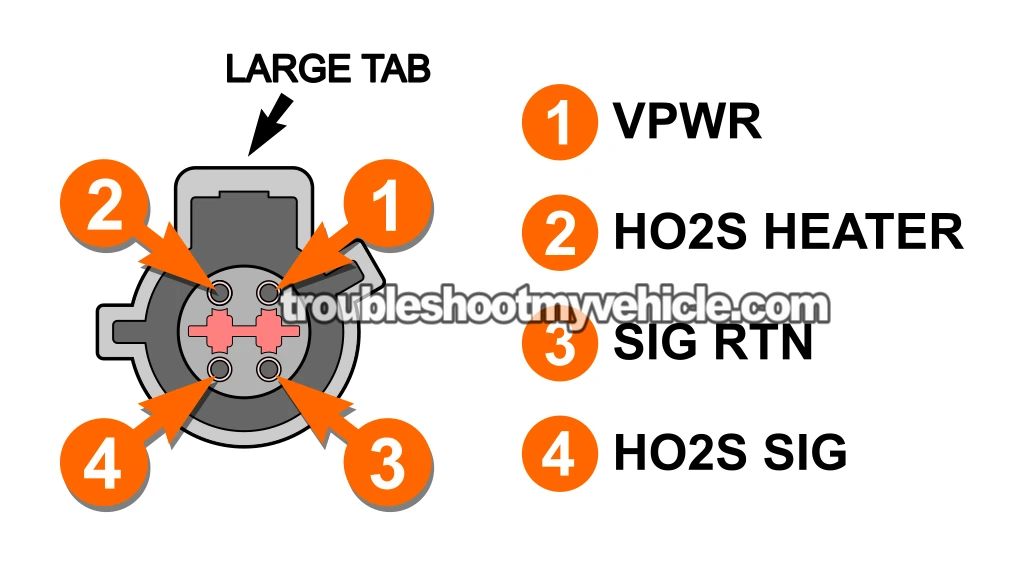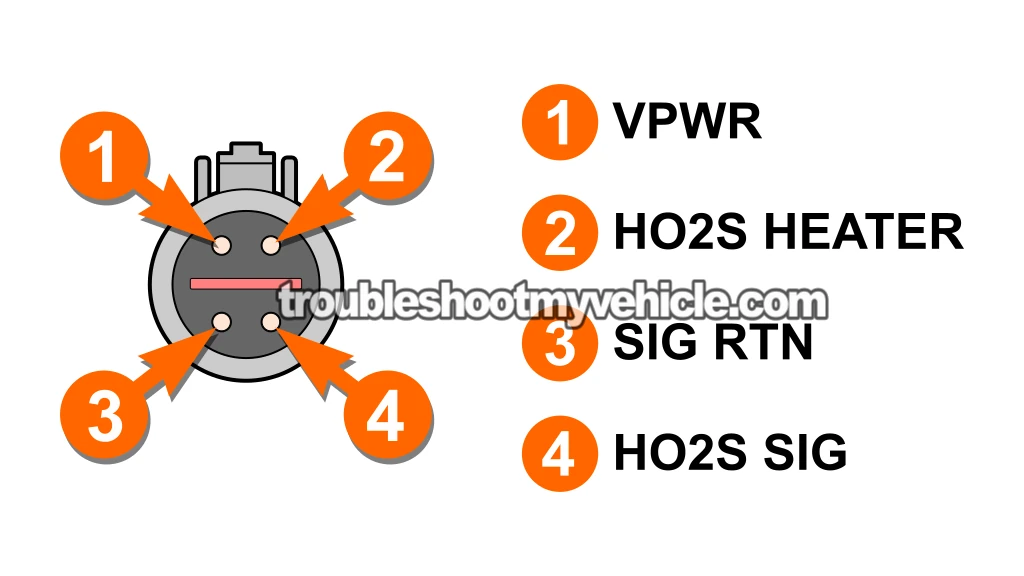
A P0161 O2 Sensor Heater Circuit Malfunction (Bank 2 Sensor 2) usually means the heater element inside the sensor is toast. The good news? We can easily test it and know for sure.
In this tutorial I'll walk you, step by step, through the following three multimeter-only checks:
- Confirm the heater is getting ignition voltage (VPWR).
- Confirm the PCM is completing the Ground path to turn the heater ON (H2OS HEATER signal).
- Check the heater element's resistance and compare to spec to see if it's burned out.
With these quick tests, you'll know whether the HO2S 22 sensor is bad and needs to be replaced —or if the problem lies elsewhere in the circuit (fuse, wiring, connector, or PCM control).
And if you'd rather skip the testing, I'll also give you a few tips to help you decide whether replacing the sensor outright makes more sense.
Contents of this tutorial:
- Should I Just Replace the Sensor Without Testing It?
- Circuit Descriptions Of The Downstream Oxygen Sensor.
- Where To Buy The Oxygen Sensor And Save.
- TEST 1: Verifying The Heater Element Is Getting Power.
- TEST 2: Verifying The Heater Element Is Getting Ground.
- TEST 3: Testing The Heater Element's Resistance.
- More 3.0L V6 Ford Escape Diagnostic Tutorials.
APPLIES TO: This tutorial applies to the following vehicles:
- 3.0L V6 Ford Escape: 2001, 2002, 2003, 2004.
- 3.0L V6 Mazda Tribute: 2001, 2002, 2003, 2004.
HO2S 22 CIRCUIT WIRING DIAGRAM:
OTHER 02 HEATER DIAGNOSTIC TESTS:
- P0135 -O2 Sensor Bank 1 Sensor 1 Heater Tests (2001-2004 3.0L V6 Ford Escape).
- P0141 -O2 Sensor Bank 1 Sensor 2 Heater Tests (2001-2004 3.0L V6 Ford Escape).
- P0155 -O2 Sensor Bank 2 Sensor 1 Heater Tests (2001-2004 3.0L Ford Escape).
Should I Just Replace the Sensor Without Testing It?
Whenever a P0161 diagnostic trouble code (DTC) lights up the check engine light, most folks will simply buy a new sensor and slap it in. And you know what? In a lot of cases, that's the solution because the heater element inside the sensor really does burn out pretty often.
There are two big reasons behind that "swap-it-first" approach:
- You might not have a multimeter handy to check the sensor's heater circuit.
- It's cheaper than taking it to the shop. Even if it doesn't fix the issue, you've still ruled out the sensor and saved yourself the shop's diagnostic fee and labor bill.
So, if your game plan is to drop in a new sensor and see what happens, that's fine —it's a valid way to troubleshoot the P0161 DTC. For your replacement O2 sensor, I want to recommend the following two from two known automotive aftermarket manufacturers that won't let you down.
- Bosch 15724 Premium Original Equipment Oxygen Sensor (Amazon affiliate link).
- Motorcraft - DY1101 Sensor (Amazon affiliate link).
Before you swap out the old sensor for the new one, there are two quick checks you really need to do first. They'll save you quite a bit of frustration if the problem turns out to be in the sensor's wiring instead of the sensor itself.
- Wiring damage:
- Check if the sensor's wires have melted against the exhaust pipe and are shorted together.
- See if the insulation's rubbed through on a sharp edge and has caused the copper strands of the wire to be exposed.
- Connector issues: Look for corrosion, loose terminals, or broken connector that can keep the heater from getting power and its activation signal.
If you do find any of these issues, you've found the source of the P0161 code and more than likely the O2 sensor itself is OK. Unless of course the wiring damage is on the wires coming out of the sensor itself, in that case you'll need to replace the sensor. After repairing any found wiring damage, make sure to tie down the wires so that they do not touch the exhaust pipe anymore.
Now, I do want to make the case for actually testing the O2 sensor before replacing it to make sure that it's actually bad and causing the P0161 code. Here are the main reasons why you should test it:
- All you need is a multimeter and a few minutes of your time.
- Only 3 easy tests involved. You're simply confirming three things: that the heater is getting power, that the PCM is sending its heater activation signal, and that the heater element's internal resistance is within spec.
- Access isn't too much of a pain. The O2 sensor is located on the lower part of the exhaust manifold that faces the radiator (front of the vehicle).
- I'll give you step-by-step instructions. You'll know in minutes whether the Bank 2 Sensor 2 O2 sensor is good or the heater inside is fried.
Where To Buy The Oxygen Sensor And Save
The following two O2 sensors are from two well-known automotive aftermarket brands. I've been using these brands for most of my automotive repair career, and I don't hesitate to recommend them:
Disclosure: As an Amazon Associate, I earn from qualifying purchases. If my tutorials help you, using these links is an easy way to support the site at no extra cost to you. Thank you!
NOTE: If you're not sure if the above O2 sensors fit your particular 3.0L V6 Escape (3.0L V6 Mazda Tribute) don't worry. Once you get to the site, they'll make sure the sensor is the right one, if not, they'll find you the right one.
TEST 1: Verifying The Heater Element Is Getting Power

The heater element inside the HO2S 22 sensor needs two things to be able to turn ON and heat the sensor: 12 Volts and Ground (its activation signal).
In this test section, we're going to make sure that the light blue with orange stripe (LT BLU/ORG) wire is delivering 10 to 12 Volts with the key in the RUN position, but with the engine OFF.
This VPWR voltage is provided by fuse 5 (15A) which is located in the Battery Junction Box (in the engine compartment).
To check for the presence of this VPWR power, we're going to do a simple multimeter voltage test at terminal 1 of the sensor's connector.
CAUTION: Make sure the engine is completely cold engine to avoid getting burned from a hot O2 sensor or exhaust manifold! Be careful and take all necessary safety precautions!
IMPORTANT: This test is done on the engine wiring harness connector which has female terminals.
TERMINAL ID: The O2 sensor connector (the one that belongs to the engine wiring harness) on your Ford Escape or Mazda Tribute has one large index tab and two small index tabs. The location of the small tabs may differ from the illustration shown in this tutorial. Always use the large index tab as your reference point when making your multimeter connections and tests.
OK, let's begin.
- 1
Disconnect the downstream O2 sensor from its engine wiring harness connector.
- 2
Turn the key ON but don't start the engine.
- 3
Set your multimeter to Volts DC mode.
- 4
Ground the black multimeter test lead directly on the battery negative (-) terminal.
You may need to use a long jumper wire to extend the reach of your multimeter test lead. - 5
Probe female terminal 1 with the red multimeter test lead.
NOTE: Make sure that terminal 1 connects to the LT BLU/ORG wire of the connector. - 6
Your multimeter should register 10 to 12 Volts DC.
Let's take a look at your test results:
CASE 1: 10 to 12 Volts are present at terminal 1. Awesome. This lets you know that the H2O S22 sensor's heater is getting the voltage it needs to activate.
Now that we've confirmed VPWR power to the heater element, our next step is to see if the PCM is actually activating the heater. For this HO2S HEATER signal test, head over to: TEST 2: Verifying The Heater Element Is Getting Ground.
CASE 2: No voltage is present at terminal 1. Double-check that you're testing the correct terminal and make sure that terminal actually connects to the LT BLU/ORG wire.
If your multimeter still doesn't report 10 to 12 Volts at terminal 1, you can rule out the sensor itself as the cause behind the P0161 trouble code lighting up the check engine light on your Ford Escape or Mazda Tribute. Without VPWR power, the sensor's heater will not activate.
You now need to focus your troubleshooting efforts into finding out why this voltage is missing and restore it to the circuit to get the O2 sensor heater functioning again and to resolve the P0161 DTC.
TEST 2: Verifying The Heater Element Is Getting Ground

In this test section, we're now going to check that the HO2S 22 sensor's heater is getting Ground.
The PCM provides this Ground via the tan with yellow stripe (TAN/YEL) wire. This wire connects to terminal 2 of the sensor's connector.
It's through this HO2S HEATER Ground that the PCM activates the heater to heat the sensor.
We can easily confirm that the PCM is providing this Ground activation signal by doing a simple multimeter voltage test at terminal 2 with the key in the RUN position (but with the engine OFF).
CAUTION: The HEATER Ground is provided internally by your Escape or Tribute's PCM, so be careful not to connect this circuit to battery 12 Volts or you'll deep-fry the PCM. The multimeter voltage test I'm outlining below is a safe way to check for this PCM-supplied Ground.
NOTE: The HO2S HEATER circuit test takes place on the engine wiring harness connector (which has female terminals) and NOT on the connector that belongs to the O2 sensor itself.
These are the test steps:
- 1
Turn the key ON but don't start the engine.
- 2
Set your multimeter to Volts DC mode.
- 3
Connect the red multimeter test lead directly on the battery positive (+) terminal.
You may need to use a long jumper wire to extend the reach of your multimeter test lead. - 4
Gently probe the female terminal 2 with the black multimeter test lead.
NOTE: Confirm that terminal 2 connects to the TAN/YEL wire of the connector. - 5
The multimeter should register 10 to 12 Volts DC.
Let's see what your test result is telling us:
CASE 1: HO2S HEATER Ground is present at terminal 2. This is the correct and expected test result, which confirms that the sensor's heater is receiving an activation signal from the PCM.
Now that you've confirmed that the heater is getting VPWR and HO2S HEATER Ground, our next step is to check the heater element's internal resistance. Go to: TEST 3: Testing The Heater Element's Resistance.
CASE 2: HO2S HEATER Ground is not present at terminal 2. Without this activation signal, the heater element within the O2 sensor isn't going to activate.
Double check your multimeter test connections and repeat the test. If you still don't see the HO2S HEATER Ground signal at terminal 2, then you can rule out the O2 sensor itself as the cause of your Escape or Tribute's P0161 DTC.
The most likely cause of this missing activation signal is an open-circuit problem in the TAN/YEL wire between the O2 sensor connector and the PCM. Your next step is to figure out why this signal is missing and restore it to the circuit.
TEST 3: Testing The Heater Element's Resistance

Your previous two tests have confirmed the following:
- The heater element is getting VPWR power at terminal 1 (TEST 1).
- The heater element is getting its activation signal at terminal 2 (TEST 2).
For our third and final test, we're going to check the internal resistance of the heater element itself. This is a pretty easy test that we'll do with our multimeter in Ohms mode.
If the heater element is OK, you should see a resistance between 3 to 30 Ohms (Ω). If the heater element is fried, you're going to see:
- Short circuit issue: A resistance close to 0 Ohms.
- Open circuit issue: The multimeter will show infinity Ohms.
NOTE: The O2 sensor has to be at ambient temperature to get an accurate resistance test result. So if the engine has been running for any length of time, let the engine and the exhaust manifold cool down completely before performing this test.
Alright, let's get our resistance test done:
- 1
Locate terminals 3 and 4 of the connector that connects directly to the O2 sensor.
NOTE: This test is done on the connector coming out of the O2 sensor itself. This connector has round male terminals. - 2
Set your multimeter to Ohms mode.
- 3
With the multimeter test leads, probe male terminals 3 and 4 of the O2 sensor connector.
- 4
Your multimeter should report a resistance of 3 to 30 Ωs.
If the heater element is fried, your multimeter will show an open (usually indicated by the letters OL) or a number over 10 K Ωs.
Let's take a look at your test results:
CASE 1: The resistance of the O2 sensor's heater element is within specification. That's the correct and expected test result, and it lets you know that the O2 sensor's heater element is OK.
At this point in time, whatever triggered the P0161 trouble code is not present since you've confirmed in the previous tests that the heater element is getting power and its activation signal, and in this test section you've confirmed that the heater element is within specification.
CASE 2: The resistance of the O2 sensor's heater element is NOT within specification. This test result lets you know that the O2 sensor's heat element is fried.
You can correctly conclude that the sensor is bad and needs to be replaced if you have:
- You have a P0161 DTC illuminating the check engine light.
- You've confirmed that the heater element is getting VPWR power in TEST 1.
- In TEST 2, you confirmed that the heater element is getting its activation signal from the PCM.
- Confirmed that the heater element is not within specification in this test section.
When you're ready to swap out the O2 sensor with a new one, I want to make the following recommendation. These are sensors from two well-known automotive aftermarket brands that I have been using for years and don't hesitate to recommend:
- Bosch 15724 Premium Original Equipment Oxygen Sensor (Amazon affiliate link).
- Motorcraft - DY1101 Sensor (Amazon affiliate link).
More 3.0L V6 Ford Escape Diagnostic Tutorials
You can find a complete list of 3.0L V6 Ford Escape tutorials in this index:
Here's a small sample of the tutorials you'll find in the index:
- How To Test The Cooling Fan Motors (2001-2004 3.0L V6 Ford Escape - Mazda Tribute).
- How To Test The Throttle Position Sensor (2001-2007 3.0L V6 Ford Escape).
- How To Test The MAF Sensor (2001-2007 Ford 3.0L V6 Ford Escape, Mercury Mariner).
- How To Test The Fuel Pump (2001-2004 3.0L V6 Ford Escape).

If this info saved the day, buy me a beer!





